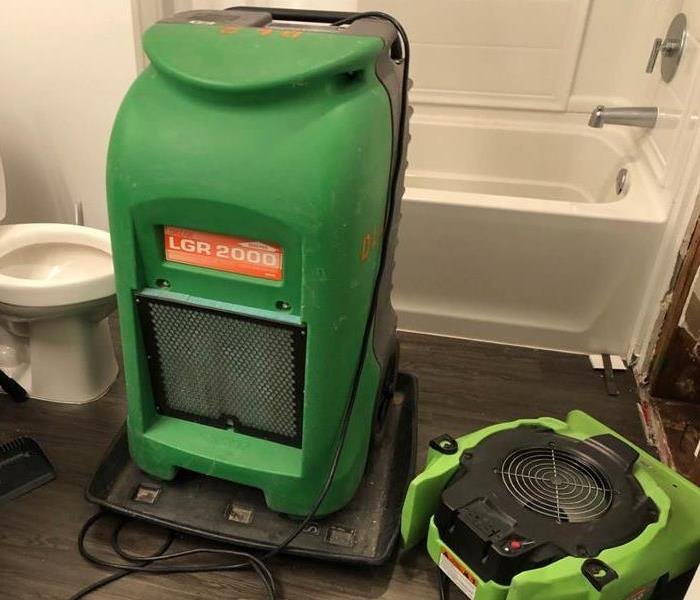What Is the Water Damage Restoration Process?
2/1/2023 (Permalink)
Water damage is a serious problem for any business. When water enters your building and causes damage to the contents and structure, you may need professional help to restore it. The water damage restoration process can be complicated and time-consuming, but it's also an important step toward making sure that your business is operating as normally as possible. In this article, we'll explain the steps involved in repairing water damage and why it's so important that you hire a specialist if you find yourself in this situation.
What Is the Water Damage Restoration Process?
The water damage restoration process is a long and complex one that involves several steps. Each situation is different, but in most cases the process can be broken down into these stages:
Pre-Inspection and Assessment
Water damage restoration professionals will perform a pre-inspection of your property. The purpose of this inspection is to determine the extent of damage, assess what repairs are needed and see if there are any immediate hazards that need attention before they can begin working on the water restoration process.
- They will check for structural damage, such as cracks in walls or floors. This can be caused by excessive moisture in the air, which causes freezing and thawing throughout your home every day during winter months.
- They will also check for electrical issues related to power surges from water appliances (such as washing machines) that have short circuits when exposed to moisture in an electric space after a flood has occurred inside your home. This could cause further destruction if not addressed immediately!
Water Removal/Water Extraction
- Water Removal/Water Extraction: The first step in the process of water damage restoration is to extract any excess moisture from your home or office. This is accomplished by using powerful vacuums and dehumidifiers, which suck the water out of your walls, floors and other structural components.
- Structural Drying: Next, we'll begin drying out your home or business. We'll use high-powered air movers to remove moisture from cracks and crevices in a process called "dehumidification." Once this has been completed, we can begin repairing any damaged areas of your property that were affected by wet conditions such as mold growth or rotting wood.
Drying and Dehumidification
Dehumidification
The drying process is not complete until the water has been removed and the humidity in your home has decreased to a safe level. This means that you may have to move out of your home while it dries, especially if you live in an area where mold and mildew are prevalent. Once you can return to your home, you will want to make sure that your belongings are completely dry before putting them back into storage.
Mold Prevention
Molds thrive in wet environments with stagnant air; therefore, one of our most important steps during restoration is keeping moisture from returning to what was once a wet area of your home or business. This can be done through dehumidification techniques like extracting excess moisture from walls or floors using special equipment designed for this purpose (such as portable air movers), installing temporary ventilation systems such as fans or portable air conditioners until permanent changes can be made to ventilation systems inside homes or buildings after they’ve been repaired by water damage repair professionals
Cleaning and Sanitizing
Once a thorough inspection is completed and the water damage has been assessed, it’s time to begin cleaning and sanitizing. This is the most important step in the restoration process. The goal here is to remove all traces of the water damage and restore your property to its original state.
The first step in this process involves removing any debris from your carpeting or flooring using heavy-duty vacuums that can handle such rough work. You may also want to consider using a shop vacuum if you have one on hand (if not, ask us about renting one). Next comes dry removal of any drywall that has been affected by flooding or leaks—this means taking down walls and replacing them with new ones where necessary. Once everything is dry and ready for repair, we'll clean up all areas before applying a fresh coat of paint or wall paper depending on what needs done at each location onsite!
Restoration
Once the water has been removed, the next step is restoration. Restoration is the process of making your property as good as new. However, depending on the severity of your flood, it may be best to hire a professional company that has special equipment and skills to perform this work.
- Cleaning and disinfecting walls, doors, floors, ceilings and furniture
- Replacing drywall where needed
- Picking up debris from yards or driveways (if applicable)
Restoration can be a lengthy process that requires special equipment and skills. In many cases you may need to replace items like carpeting or insulation because they're wet and cannot be salvaged by drying them out alone.
When to Consult a Specialist for Water Damage Restoration
You should consider hiring a water damage restoration company if:
- The damage is severe and widespread.
- You are unsure about the source of the water damage.
- You have questions about the restoration process.
- You have questions about your insurance claim, which may involve filing a claim or filling out paperwork with various parties (such as your insurer or mortgage lender).
In addition to these factors, you should also be aware that it may cost more money to hire a specialist versus doing it yourself.
The water damage restoration process is a complex one and requires expertise. If you have any signs of water damage in your home, contact us immediately. We can help determine what’s been damaged, how much it will cost to fix and whether or not you need professional assistance.

 24/7 Emergency Service
24/7 Emergency Service
